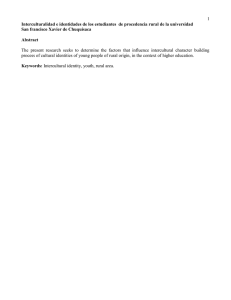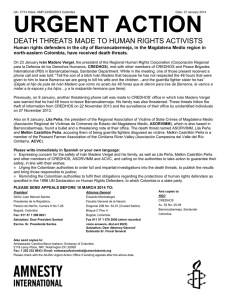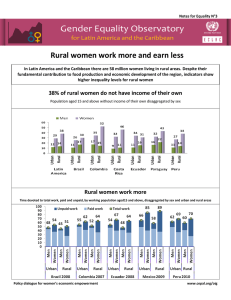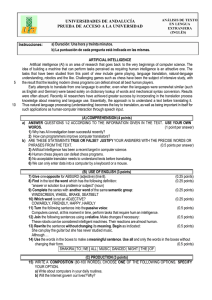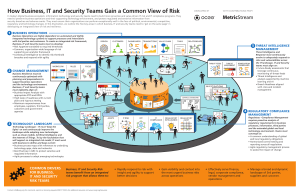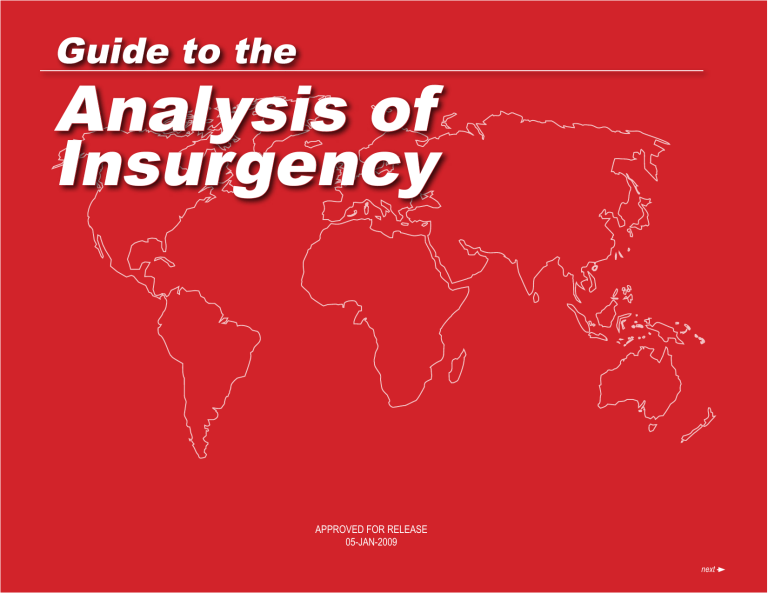
Guide to the Analysis of Insurgency Approved for release 05-Jan-2009 1 next Contents 2 Scope Note Insurgency Defined Common Insurgent Objectives Stages of an Insurgency Types of Insurgency Incipient Insurgency Determinants of Control in Insurgency Late-Stage Indicators of Successful Insurgencies Effective Counterinsurgency Analyzing an Insurgency: A Net Assessment Notes 3 3 3 4 5 7 9 12 13 15 16 previous ~ next Guide to the Analysis of Insurgency Scope Note This pamphlet contains key definitions and analytic guides applicable to any insurgency. Analysts with knowledge of the political, military, and socioeconomic characteristics of a specific insurgency will find these definitions and frameworks helpful in evaluating the major components of the conflict. Among other things, this guide is designed to assist in conducting a net assessment of the overall status or progress of a specific conflict. Insurgency Defined Insurgency is a protracted political-military activity directed toward completely or partially controlling the resources of a country through the use of irregular military forces and illegal political organizations. Insurgent activity—including guerrilla warfare, terrorism, and political mobilization, for example, propaganda, recruitment, front and covert party organization, and international activity—is designed to weaken government control and legitimacy while increasing insurgent control and legitimacy. The common denominator of most insurgent groups is their desire to control a particular area. This objective differentiates insurgent groups from purely terrorist organizations, whose objectives do not include the creation of an alternative government capable of controlling a given area or country. Common Insurgent Objective Most insurgent groups have the same intermediate objectives designed to help them achieve eventual domination of a country. Although both military and political means are used to achieve these intermediate objectives, the objectives themselves are essentially political: • Limit the ability of the government and enhance the capability of the insurgents to services. provide public • Obtain the support or neutrality of critical segments of the population. • Isolate the government from international diplomatic and material support and increase international support for the insurgents. • Increase domestic and international legitimacy of the insurgent organization at the expense of the government. • Destroy the self-confidence of government leaders and cadres, causing their abdication or withdrawal. • Reduce and, if possible, neutralize government coercive power while strengthening insurgent coercive capabilities. 3 previous ~ next Stages of an Insurgency Successful insurgencies usually pass through certain common stages of development. Not all insurgencies, however, experience every stage; the sequence may not be the same in all cases; and the evolution of any stage may extend over a long period of time. An insurgency may take decades to start, mature, and finally succeed. The stages of an insurgency are: Stage Insurgent Action Government Response Preinsurgency Leadership emerges in response to domestic grievances or outside influences. Minimal. Organizational Infrastructure built, guerrillas recruited and trained, supplies acquired, and domestic and international support sought. Counterinsurgency organization created. Guerrilla warfare Hit-and-run tactics used to attack government. Extensive insurgent political activity—both domestic and international—may also occur simultaneously during this stage. Low-level military action initiated. Political, social, and economic reforms; civic action programs; psychological operations; and amnesty programs may also be initiated to counteract the insurgents' political activities. Mobile conventional warfare Larger units used in conventional warfare mode. Many insurgencies never reach this stage. Conventional military operations implemented. 4 previous ~ next Types of Insurgency Insurgencies generally fall into one of four broad categories—politically organized, militarily organized, traditionally organized, or urban—although some insurgencies have characteristics of more than one type. The defining quality of each category is the group's organizational strategy. Differences in organization¬al approach, in turn, produce differences in the military and political strategies employed by the insurgents at the international, national, provincial, and village levels of the conflict. Organizational strategy is determined primarily by the group's operational environment and by the training of its leaders. The operational environment includes the sociocultural makeup of the target population; the economic, political, and geographic characteristics of the area of operations; the insurgents' initial strength; the role of outside parties; and government capabilities. These factors frequently override training and ideology as a determinant of strategy in successful insurgencies; guerrillas who cannot adjust their strategy to suit local conditions rarely survive. Many politically, militarily, and traditionally organized insurgencies have urban components despite their rural concentration. Insurgent cadres often have strong ties to the cities, and many opposition leaders have attempted city-based revolts before adopting rural-based strategies. An urban component aids a rural-based insurgency by tying up government forces and providing financial, intelligence, and logistic services. Additionally, insurgent "armed propaganda" in urban areas usually receives better media coverage than that perpetrated in the countryside. Insurgencies of several types may occur simultaneously within the same country. However, differences in organizational strategy, as well as differences in ideology, motivation, leadership, and cadre background, make unification of insurgencies of different types difficult. 5 previous ~ next The Four Broad Categories of Insurgency Organizational Structure Objective/Strategy Vulnerabilities Other Characteristics Shadow government created to undermine authority of existing regime; political consolidation precedes military consolidation of contested areas. Vulnerable to concentrated effort aimed at neutralizing the infrastructure and establishing administrative control in contested areas. Protracted warfare; tendency toward excessive revolutionary zeal. Insurgent groups hope to form focus for disaffected population; destruction of regime legitimacy by military action; military consolidation precedes political consolidation of contested areas. Vulnerable to aggressive military action during early stages of rebellion because of undeveloped political structure, relatively vulnerable logistics and communications networks, and lack of clandestine networks among local populations. Hope to demoralize regime and attain power without extensive conventional warfare. No unique strategy common to all; will adopt strategy of one of the other types. Limited capacity for absorbing economic and military punishment; leadership conflicts are common; leaders often lack sufficient motivation, experience as insurgents, and political discipline. Recruitment on basis of ethnic exclusivity. Threaten regime legitimacy through urban disruption. Restricted to small area and must hide within population; attrition resulting from military/police pressure and the psychological stress of clandestinity. Often in support of wider insurgency waged in rural area. Politically organized insurgency Extensive, complex political structure developed before military operations are initiated. Militarily organized insurgency Small, decentralized structure of armed insurgents serving as a catalyst for mobilizing opposition against existing regime. Traditionally organized insurgency Existing tribal or religious organizational structure. Urban insurgency Cellular structure in urban environment. 6 previous ~ next Incipient Insurgency The concept incipient insurgency-which encompasses the preinsurgency and organizational stages of an insurgent conflict—refers to situations ranging from those in which subversive activity by an inchoate insurgent group is but a potential threat to those in which antigovernment incidents occur frequently and display organization and forethought. Yet not all incipient insurgencies pose a serious challenge to a government. Determining which evolving insurgencies constitute a serious threat involves evaluating a range of signs associated with the development of an insurgency. A revolutionary group seeking to mount an insurgency must, at a minimum, build an organization, recruit and train people, acquire supplies, and broadcast beliefs and goals. It may also choose to incite riots or work stoppages, infiltrate the legitimate political apparatus, and engage in terrorism—the more numerous the signs that a group is engaging in these activities, and the greater the magnitude of each sign, the more serious the threat. The most alarming signs—those that almost certainly would signal the beginnings of a serious insurgent threat—involve substantial foreign assistance, either from governments or experienced insurgents; extensive guerrilla training; the acquisition of large quantities of guerrilla resources; and the creation of an organization (with both a political and military arm) capable of substantially increasing its membership. The signs associated with the development of an insurgency fall within the following six categories: Organization and recruitment: • Sudden departure of large numbers of young or skilled people for some form of training or indoctrination. • Defection of a noticeable number of members, especially leaders, from one political party or organization to a more radical party. • Measurable increase in ideological proselytizing in rural areas. • Increase of "visitors" from proinsurgency countries or the return of exiles. • Reports of "cells" in urban areas. • Press "leaks" on guerrilla plans or programs to change the country. Note: Well-developed and successful insurgent groups will be organized and divided along functional lines. Their ideology will be well developed, and their goals will be well defined, obtainable, and will reflect long-range planning. 7 previous ~ next Training: • Reports of people training with arms or the identification of nongovernment military training sites. • Reports of people receiving training outside the country or of travelers to countries sympathetic to insurgents. Acquiring resources: • Discovery of arms and materiel caches, collections of police uniforms or military clothing, stockpiles of explosives. • Evidence of multiple thefts of weapons. • Evidence that a group has access to or has stolen special or sophisticated equipment—for example, multiple thefts of amateur band transceivers, hand-held VHF/UHF radios, directional antennas, cassette recorders, calculators, typewriters, and printing presses. • Evidence of robberies, kidnap ransoms, narcotics income, or protection rackets linked to a radical group. Outside support: • Evidence of money, training, arms, and materiel provided by foreign governments. • Evidence of assistance or cooperation with foreign insurgent groups. Popular support: • Evidence that insurgents have connections with legitimate groups—political parties, labor unions, the church. • Growing media coverage of insurgent activities. • Evidence that the number of sympathizers is growing—for example, people who are not formal members but support demonstrations. • Indications that the insurgents are increasingly sensitive to public attitudes and reactions. 8 previous ~ next Actions/use of violence: • Emergence of radical violence, including bombings and attacks against government personnel and buildings, essential utilities, symbolic targets, or foreign-owned properties. • Reports of infiltration into the government, labor unions, political parties. • Overzealous support of land reform, including non-government-sponsored expropriation of land or the establishment of squatters' encampments. • Sightings of armed people in rural areas. • Reports of meetings at which discussions center on initiating violence. • Discovery of the capability to produce counterfeit documents. • Assassination of authority figures or religious leaders. • Violence in foreign countries directed against the diplomatic community of the country of concern. • Production and circulation of large quantities of radical propaganda. • Establishment of front organizations. Determinants of Control in Insurgency Determinants of Control The ability to measure or assess who has control over an area and its population—the insurgents or the government—is an important element in an in Insurgency insurgency or counterinsurgency effort. Who has control is determined not merely by who has more guns and firepower but primarily by who has more sympathizers-informers, food suppliers, messengers, and taxpayers—and committed supporters-cadres, soldiers, tax collectors, and risk takers. Support of the people is vital to the survival of the insurgents who depend on them for food, shelter, recruits, and intelligence. The government's challenge is to regain the allegiance of a population already alienated by government failures to address basic grievances. Poor peasants and farmers are, however, seldom motivated by abstractions or vague promises. Their willingness to provide support hinges on concrete incentives—material benefits or demonstrable threats. Three factors—attitudes, organization, and security—are critical to establishing control. One is best able to analyze the contest for control by answering several questions related to each of these factors. 9 previous ~ next Attitudes Neither the government nor the insurgents can control an area without the sympathetic support of part of the local population, including at least a small core of individuals willing to undertake risks. Favorable attitudes among the local populace: • Is the rural population highly receptive to government/insurgent propaganda? • Are acts of government repression/guerrilla terrorism perceived locally as indiscriminate or discriminate? • Do government/guerrilla combat operations have exclusively military goals? Or, do combat operations consider the psychological and political impact on the local population? • Are there government/insurgent policies that the peasants feel are particularly unfair? Ability to motivate individuals to take risks: • Are local government officials/guerrilla leaders drawn mainly from the local population, or are they outsiders? • Are civilian militias/guerrilla bands composed mainly of local residents, or are they outsiders? • What percentage of households in a community have members in the local civilian militia? Organization The organizational capabilities exhibited by each side at the local level are vital to mobilizing and utilizing local resources, orchestrating propaganda activities, and ensuring the effectiveness of local security forces. Ability of organizations to mobilize and organize people locally: • Do the villagers participate in government- or insurgent-sponsored civilian activities? Is participation voluntary? • Are local government/insurgent leaders dynamic personalities capable of injecting vigor into their organizations? 10 previous ~ next Ability of organizations to provide material benefits to supporters at the local level: • Does membership in government/insurgent organizations provide an opportunity for upward mobility or economic reward? • Do government programs or guerrilla recruitment significantly improve employment opportunities at the local level? • Are government services perceived locally as adequate? Or, are there generalized complaints condemning bureaucratic incompetence, redtape, or corruption? • Is the rural population supportive of government/insurgent programs de-signed for its benefit (such as land reform, rent control, cooperatives, and credit)? Ability of organizations to exploit local resources: • How successful are government officials/insurgents in collecting taxes and receiving services and recruits from the local population? • Do government officials/insurgent leaders implement national government/insurgent directives inflexibly or do they adapt them to local conditions? Security It is essential that each side be capable of protecting its local political apparatus, cadres, and supporters from enemy forces and assassins. Failure to perform this function is usually accompanied by a breakdown in morale and discipline, and occasionally by a complete collapse of one's entire organization. Ability to protect supporters and local population: • Do government/guerrilla forces adequately protect local supporters on a 24-hour basis? • Do national army "reaction forces" respond quickly and effectively to reports of guerrilla attacks on local civilian militias or progovernment communities? • Do local government officials/insurgent cadres sleep in villages, or do they seek protection of armed camps? •Are national army troops/guerrillas viewed locally as threatening outsiders or as helpful allies? • Is the local militia seen as a source of protection by the rural population or as merely another distrusted police force? 11 previous ~ next Local military effectiveness: • Are local civilian militias aggressive in small-unit, day and night patrolling, or do they avoid contact with the enemy? • Do government/guerrilla forces have an effective intelligence network at the local level? • How disciplined are government/insurgent forces in combat? Do they usually recover the weapons and bodies of fallen comrades before retreating? • Are local government/insurgent forces capable of executing coordinated attacks against nearby enemy strongpoints? Late-Stage Indicators of Successful Insurgencies An analysis of historical cases indicates that a common pattern of behavior and Late-Stage Indicators of events characterizes the defeat of a government battling an insurgency. This Successful Insurgencies pattern comprises four categories of developments: • Progressive withdrawal of domestic support for the government. • Progressive withdrawal of international support for the government. • Progressive loss of government control over population and territory. • Progressive loss of government coercive power. These categories include a total of 14 interrelated and mutually reinforcing indicators of prospective insurgent victory. Historically, the indicators have not appeared in any single order. Moreover, while no single indicator can be considered conclusive evidence of insurgent victory, all indicators need not be present for a government defeat to be in progress. While the indicators are designed to identify a progression of events typical of the final stages of a successful insurgency, this progression is not inevitable. Effective government countermeasures can block the evolution of an insurgency and shift its momentum. Within the four categories, the indicators are: Progressive withdrawal of domestic support for the government: • Withdrawal of support by specific, critical segments of the population. • Growing popular perception of regime illegitimacy. • Popular perception of insurgents as leading nationalists. • Insurgent co-optation, incorporation, or elimination of other major opposition groups to the government. 12 previous ~ next Progressive withdrawal of international support for the government: • Withdrawal of foreign support by specific, critical allies. • Increasing international support for the insurgents. Progressive loss of government control over population and territory: • Significant expansion of territory under insurgent control. • Escalation of guerrilla/terrorist violence. • Increasing inability of government to protect supporters/officials from attack. • National economy increasingly weakened by insurgent activity. Progressive loss of government coercive power: • Military plots or coups against the government. • Armed guerrilla forces multiplying in size. • Lack of sufficient government troops for counterinsurgency. • Government seriously negotiating sharing of power with rebels. Effective Counterinsurgency A country faces or soon may face an insurgency. Can its government wage a successful counterinsurgency campaign? What variables should be evaluated? At least 14 factors—seven military and seven nonmilitary—are critical to a government's counterinsurgency effort. Virtually all of these factors influence popular support for the government's cause. They also affect the government's ability to employ the various combinations of persuasion and coercion that are essential to successful counterinsurgency. Military factors: • Leadership. The degree of professionalism that characterizes a country's military force. • Tactics and strategy. The ability of counterinsurgent forces to employ the various unconventional strategies and tactics required for combating insurgents in the field—tactics that deemphasize the concentration of forces and firepower and emphasize constant patrolling by many small, lightly armed units supported by larger backup forces. • Military intelligence. The ability of the military intelligence apparatus to collect, analyze, and exploit quality intelligence on guerrilla personnel, modus operandi, and locations, not just on insurgent order of battle. 13 previous ~ next • Troop behavior and discipline. The quality of the relationship between soldiers deployed in the field and the surrounding population. • Air and naval operations. The quality of air and naval support to the government's ground counterinsurgency forces—for example, fire support, reconnaissance, supply transport, medevac. • Civil-military relations. The ability of civilian authorities to influence military operations, especially with regard to proper consideration for political objectives. • Popular militia. A government's ability to establish and maintain a popular militia to assist regular forces in maintaining security. Nonmilitary factors: • Police operations. The ability of the police to maintain law and order and implement population- and resources-control programs. • Civilian intelligence. The ability of the civilian and police intelligence organizations to collect, coordinate, evaluate, and exploit intelligence on the insurgents and their political/military activities. • Psychological operations. The quality of a government's psychological war¬fare effort, its information and media activities, and its ability to promote its cause domestically and internationally. • Unified management of counterinsurgency. The government's ability to establish an organizational infrastructure capable of coordinating a coherent counterinsurgency campaign. •Political framework. The overall political form and appeal of the government and the validity of its claim that it is the legitimate expression of the people's aspirations and of the country's traditions and ethos. • Improvement of rural conditions and administration. The ability of the government to implement the programs and reforms necessary to gain popular acquiescence in and support for the government's efforts against the insurgents. • Legal reform. The ability of the government to implement and administer special laws and regulations specifically designed to counter and suppress the insurgency. 14 previous ~ next Analyzing an Insurgency: A Net Assessment Analyzing the status or progress of an insurgency—that is, conducting a net assessment—involves a careful evaluation of the major factors determining which protagonist has the advantage and why. It requires a clear understanding of the conflict's setting and origins, an appreciation of each side's strategy for victory, and an assessment of each side's political and military capabilities and performance in light of their strategy. The definitions and other analytic frameworks contained in this guide help array the building-block knowledge necessary to conduct an overall assessment. The diagram that follows depicts the flow of this analytic process when applied to a specific insurgency. Insurgent Overall Strategy • • • • Setting Goals Approach (political or military) Location (urban or rural) Timing • Historical context • Geography • Societal, economic, and political processes • Stability of society • • • • • • • • • • • • • • Nature of appeal Size and composition of audience Leadership Intelligence/counterintelligence Recruitment Training Mobilization of domestic support Foreign aid Rural administration Protection/security Reforms Justice Corruption Indiscriminate use of violence Counterinsurgent Overall Strategy • • • • 15 Insurgent Political Performance and Capabilities Goals Timing Attrition-dominated strategy Consolidation-dominated strategy • • • • • • • • • Insurgent Military Performance and Capabilities Order of battle Technological sophistication Command and control Lines of communication Military leadership Combatant proficiency Tactical intelligence Ability to protect operational base Scope and timing of operations Counterinsurgent Political Performance and Capabilities Overall Assessment • Population and territory controlled by each side • Political and military performance and suitability, given overall strategy • Judgment concerning who holds the initiative • Assessment of trends in domestic and international support for each side • Judgment concerning who is in the best position.to sustain a drive toward their overall goal Counterinsurgent Military Performance and Capabilities previous ~ next Notes: 16 previous
